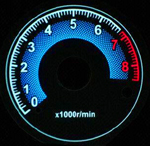Electroluminescence is the Optical and Electrical phenomenon in which a material emits light when current passes through it. This phenomenon is entirely different from the emission of light from bulbs and other light emitting devices. It is resulting from the radiative recombination of electrons and holes in a semi conductor material. The excited electrons generate Photons to give light. LEDs and Phosphor displays are typical examples of electroluminescent lighting.

In Light Emitting Diodes, the electrons and Holes are separated by a doping material to form a p-n junction. Therefore LEDs are described as “Semiconductor Electroluminescent Devices“. But in Phosphor displays, the high energy electrons are accelerated by a strong electric field to produce light.
Structure of Electroluminescence Device
Electroluminescent devices have thin film of organic or inorganic material containing semiconductor and a material called Dopant to give colour. The different materials used to make electroluminescent devices are Zinc Sulphide doped with Copper or Silver, Blue diamond doped with boron, Gallium Arsenide, Gallium Nitride etc. The Zinc –Manganese material emits yellow orange colour. These organic and inorganic materials are used as powder in lighting devices or as thin films in display devices.
The EL device has the light emitting material enclosed between two electrodes. One electrode is transparent that allows the light to pass through it. Glass electrode coated with Indium oxide or Tin oxide is usually used as the front transparent electrode. The back electrode is usually coated with a reflective metal.
Applications of Electroluminescence lighting
Electroluminescent light is now widely used in Automotive dash board, CD players etc. Powder phosphor panel is used as the back light in Laptops, computer monitors and in LCD. The advantage of electroluminescent light includes low energy consumption and good lighting display.
The use of electroluminescent lighting is generally in the area of backlighting. It is used as backlight in liquid crystal display (LCD), keypads illumination, watches, handheld remote control appliances, thermostats, clocks, calculators, mobile phones etc. The advantage of EL is that it consumes very little power compared to LEDs. As such, it is used mostly in handheld devices where batteries are used to power up the device. It is usually used to illuminate displays or keypads in the dark for a momentary period of time. It also light up an area evenly and looks good compared to LEDs. The colors of EL lamp varies and the common colours are greenish or bluish depending on the materials used.
Properties of Electroluminescence Devices
Unlike filament lamps or LEDs, in EL Devices, the brightness of the surface appears the same from all angles of view. EL light is not directional and cannot be compared with the light sources measured in lumens. The EL light is homogenous and can be perceived well. The Monochromatic light from these devices has very narrow bandwidth and is visible from great distance. The amount of light emitted from the EL lamp depends upon on the voltage and the frequency applied to it. When the voltage and frequency increases, the light output from the lamp also increases. However, one must take note of the maximum voltage and frequency that are to be used or else the lifetime of the lamp will be reduced significantly.
Filed Under: Electronic Projects


Questions related to this article?
👉Ask and discuss on EDAboard.com and Electro-Tech-Online.com forums.
Tell Us What You Think!!
You must be logged in to post a comment.